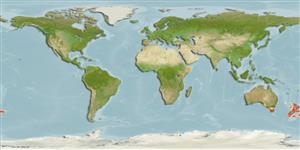| Native range | All suitable habitat | Point map | Year 2100 |

|
| Pseudophycis bachus AquaMaps Data sources: GBIF OBIS |
Length at first maturity
Lm 52.0, range 45 - 55 cm
Human uses
Fisheries: highly commercial; gamefish: yes
Phylogenetic diversity index
(Ref. 82805)
PD50 = 0.6250 many relatives (e.g. carps) 0.5 - 2.0 few relatives (e.g. lungfishes)
Trophic Level
(Ref. 69278)
4.5 ±0.80 se; Based on food items.
Resilience
(Ref. 69278)
Medium, minimum population doubling time 1.4 - 4.4 years (K=0.4(?); tm=4; Fec~1million)